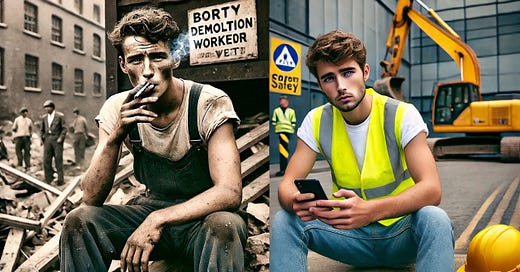Failure to engage
There has never been a better time to work in demolition and construction. So why are we failing to attract new entrants to the sector?
There was a time when building something — anything — was seen as a noble pursuit. It wasn’t glamorous. It didn’t need to be. But to work with your hands, to leave behind something real and lasting? That was enough. That was everything.
Demolition and construction wasn’t merely a job. It was a calling. A vocation. A trade in every sense of the word; hard-earned and hard-learned. It wasn’t clean or safe. There were no hard hats, no safety briefings, no mental health initiatives. It was dusty, dangerous, physically punishing. Workers operated without the protection of the rules and systems we take for granted today. And yet, those who toiled on site did so with pride. Their value wasn’t measured by degrees or titles but by what they left standing when the dust settled.
Ask any veteran of that era, and they’ll tell you: you came home tired, often injured, but you came home proud. You built things. You broke things. And society — for the most part — recognised the dignity in that.
How far we’ve drifted.
Today, the demolition and construction industry is seen not as a destination, but as a detour; a fallback plan for those who didn’t quite make the cut elsewhere. A career of last resort. A profession for those who “didn’t do well at school,” or who “weren’t cut out for office life.” Construction has become the job you settle for. Demolition, the job you fall into. And therein lies the great irony.
Because the truth is: today’s industry is better than it has ever been. Safer. Smarter. More sophisticated. More rewarding.
Workplace fatalities have dropped. Mental and physical wellbeing are now part of the conversation. Protective gear is the rule, not the exception. Site safety protocols cover all eventualities. Structured training programmes and apprenticeships offer clearly defined career paths. There are qualifications, leadership development, and transferable skills. This is not an industry of back-breaking toil alone. Not anymore.
And what’s more, today’s industry plays to the strengths of the very generation that refuses to embrace it.
Think about it. Today’s projects begin not with blueprints and hand sketches, but with drones and 3D scans. Planning meetings are conducted using tablets and project management software. Excavators, dozers, and even remote-controlled robots are operated with precision systems that feel more like video games than heavy machinery. For a young person who’s grown up with Xbox or PlayStation, the controls of a modern excavator are far more familiar than a typewriter or filing cabinet.
Drones conduct topographical surveys. GPS systems guide earthmoving equipment with millimetre accuracy. Augmented reality overlays designs onto real-world sites. AI is beginning to play a role in estimating, procurement, scheduling, and even site safety monitoring. This is no longer a world of bricks and hammers alone. It’s a world of data, design, digital tools, and decision-making — all of which align perfectly with the digital fluency of a younger generation.
And yet… the industry stands at the edge of a critical skills cliff.
Recruitment is harder than ever. Apprenticeship uptake lags behind demand. Young people are not merely turning their backs; they’re not even looking in our direction to begin with.
Why?
It’s not the work. The work has evolved. It’s not the risk. That has been reduced. It’s not the pay. In many cases, salaries rival or exceed so-called “white collar” roles.
No, it’s perception.
We’ve allowed an entire generation to grow up believing that the trades are a second-class option. That success only lives in office towers and boardrooms. That respect comes from university degrees and fancy titles, not tools. That getting your hands dirty means you didn’t try hard enough to keep them clean.
We’ve failed to tell our story.
We haven’t shown what a career in demolition or construction really looks like today. We haven’t told young people that they can earn while they learn. That they can start on the tools and move into management, surveying, estimating, or entrepreneurship. That they can spend a career outdoors, building legacies; or indoors, modelling the future in 3D. We haven’t told them that this industry still rewards hard work, still values loyalty, still offers a sense of tangible accomplishment that few other sectors can match.
Instead, we’ve allowed popular culture to do the talking. And popular culture — with its caricatures of the builder as the fool, the yob, the dropout — has done a damn good job of silencing us.
At the very moment when we’ve modernised, professionalised, and digitised, we’ve also vanished from the map of career ambition. We’ve made the work better, and yet it’s never seemed less attractive.
That’s the bitter paradox.
We need young people. Not as warm bodies, but as innovators, as leaders, as torchbearers. We need their digital instincts. Their comfort with screens and simulations. Their curiosity and creativity. We need them to question old ways of doing things. We need them to care.
And we know that many would thrive here, if only they could see what the industry really is, not what it used to be.
This is not about bringing back the past. We don’t need to revive the dirt and danger to restore the pride. We’ve already done the hard work of transforming the industry. We’ve made it fit for the future.
Now we need to make it appealing for those who will live in that future.
Because if we don’t, the consequences won’t just be felt on empty building sites or behind idle machines. They’ll be etched into the housing shortages, the crumbling infrastructure, and the economic stagnation that comes from not having enough skilled hands to shape the world we need.
The irony is brutal. We’ve made the industry better in almost every way. But in doing so, have we also made it appear unremarkable?





